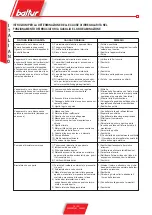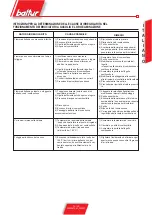
E
N
G
L
I
S
H
12 / 20
0006081081_200907
HYDRAULIC DIAGRAM
N° 0002901440
1 - 1
st
stage nozzle
2 - 2
nd
stage nozzle
3 - atomizing group with adjustable closing device
4 - 1
st
stage nozzle closing device
(pressure selling 12 bar)
4/1 - 2
nd
stage nozzle closing device
(pressure selling 12 bar)
FRONT VIEW
5 - closing device adjusting screw
6 - 1
st
stage normally open valve
7 - 2
nd
stage normally closed valve
8 - fuel pump (pressure selling: 16 bar)
9 - return pipeline
10 - suction pipeline
11 - air control servomotor
During this manoeuvre an adjustable cam, which is
activated by the same motor that moves the damper,
closes an electrical contact which takes the current to
the solenoid valve (7) (closed during the rest phase).
The opening of the second stage valve permits
the fuel, at a pressure of 16 bar, to reach the
second stage nozzle closing device n° 4/1.
The pressure acts on the second stage nozzle closing
device which, up to a pressure of 12 bar, prevents the
flow of fuel to the second nozzle. The pressure of 16
bar now acts on both nozzles.
Note:
It is clear from the above that the choice of nozzles,
depending required total flow (2 nozzles working),
must be made taking account of the flow values
corresponding to a working pressure of 16 bar.
You must however bear in mind that when the burner is
working with only the first stage switched on, the supply of
fuel corresponds to a single nozzle at a pressure of 16 bar.
It is of course possible to change the ration between
first and second stage within wide limits by changing
the nozzles. Remember however that for the good
working of the system, the supply of fuel in the first
sage should not be less than the minimum capacity
(which is written on the burner’s specifications plate).
A lower flow could make ignition difficult and first stage
combustion alone may not be good.
These burner models use three nozzles; in the case of
second stage nozzles there are two and both are at a
pressure of 16 bar.
From when the flame appears in the combustion
chamber, the burner is controlled by the photoelectric
cell and the thermostats. When the temperature or
pressure reaches the value at which the thermostat or
pressure switch is calibrated for working, the burner will
stop when it is triggered.
The control box starts working again automatically when
the temperature or pressure is lowered by the necessary
amount. If, for any reason, during the working, the flame
goes out, the photoelectric cell intervenes immediately
(within one second) to stop the electrical supply to
the relay, causing it to open with the result that wash
solenoid valve n°6, on opening, rapidly discharges the
existing pressure and the light atomised oil spray is
intercepted by the automatic closing of the atomisation
unit nozzle as soon as the pressure goes below set
pressure. The burner has a display diagram switch (3)
to go from the 1
st
to the 2
nd
stage.
















































